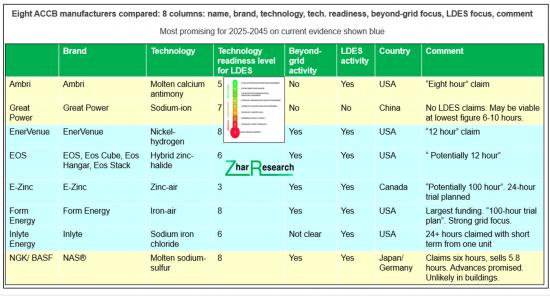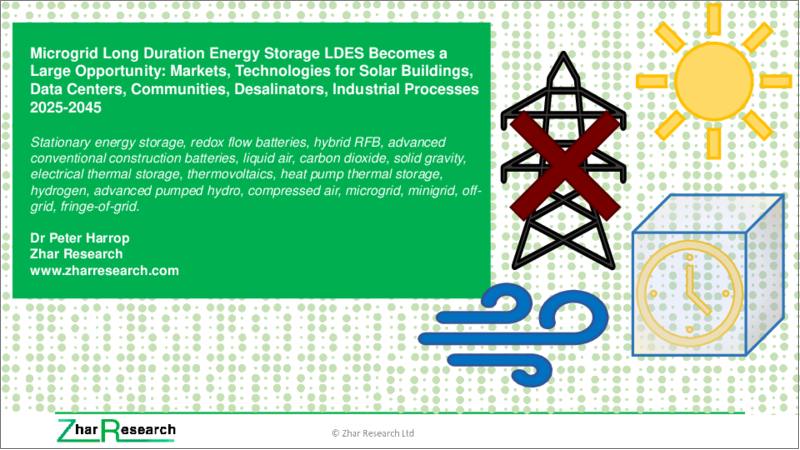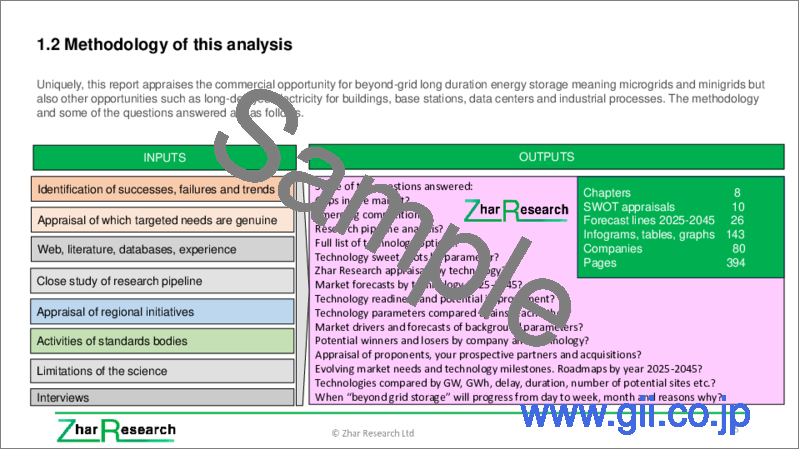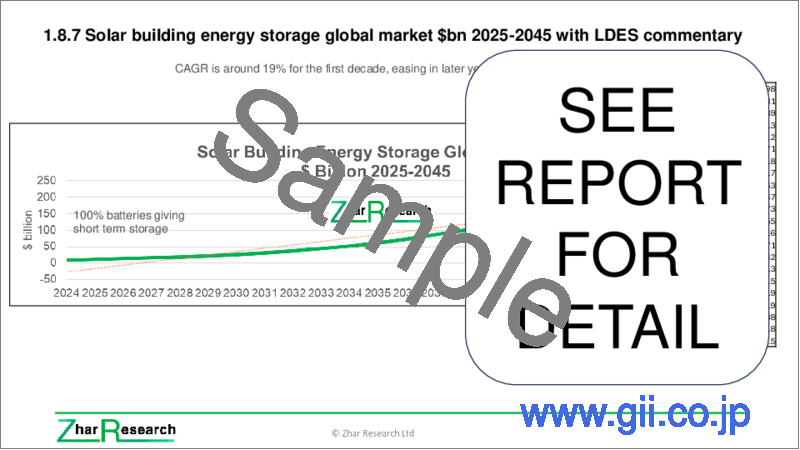|
|
市場調査レポート
商品コード
1638133
マイクログリッドLDES (長期エネルギー貯蔵) が大きな機会に:ソーラービル、データセンター、コミュニティ、淡水化装置、産業プロセス向けの市場と技術 (2025-2045年)Microgrid Long Duration Energy Storage LDES Becomes a Large Opportunity: Markets, Technologies for Solar Buildings, Data Centers, Communities, Desalinators, Industrial Processes 2025-2045 |
||||||
|
|||||||
| マイクログリッドLDES (長期エネルギー貯蔵) が大きな機会に:ソーラービル、データセンター、コミュニティ、淡水化装置、産業プロセス向けの市場と技術 (2025-2045年) |
|
出版日: 2025年01月21日
発行: Zhar Research
ページ情報: 英文 394 Pages
納期: 即日から翌営業日
|
全表示
- 概要
- 目次
マイクログリッドLDES (長期エネルギー貯蔵) の市場は540億米ドルの規模となる見通し:
LDESは主に送電網用の主流のストレージと見なされていますが、重要な他の用途においてはさまざまに異なる要件や技術の優先順位があり、競合が少ない状況です。

当レポートでは、マイクログリッドLDES (長期エネルギー貯蔵) の市場および技術を調査し、グリッドおよびビヨンドグリッドLDESの有力な候補となる技術とその他の技術についての概要、重要機能、製造技術と材料、エンドユーザー産業と用途、研究開発動向、市場成長予測などをまとめています。
目次
第1章 エグゼクティブサマリー・総論
第2章 イントロダクション
- 概要
- LDES
- 世界の電力動向
- ビヨンドグリッド:建物、産業プロセス、ミニグリッド、マイクログリッド、その他
- ビヨンドグリッドの発電と管理
- オフグリッドのメガトレンド
- 太陽光発電のメガトレンド
- LDESの展望とコストの課題
- ビヨンドグリッド貯蔵の多機能性
- グリッドおよびビヨンドグリッドにおけるLDES技術の可能性の全体像
- グリッドおよびビヨンドグリッド向けのLDESツールキット
- LDESにおける物理と化学
- グリッド、マイクログリッド、建物向けLDESの最大数を実現する技術
第3章 LDES貯蔵オプションの比較:パラメータ別
- LCOSの概要、定義、有用性
- 等価効率 vs 貯蔵時間:LCOS計算、9つの技術ファミリー、17の基準
- 9つのLDES技術ファミリーとその他の17の基準
- グリッドを含むLDES技術の選択肢
- 完了および計画中のLDESプロジェクトからの教訓
- LDES技術の利用可能なサイトとスペース効率
- LCOS ($/kWh) の傾向 vs 貯蔵および放電時間
- LDES電力のGWの傾向 vs 貯蔵および放電時間の関係
- LDES技術の貯蔵日数と定格電力回収量 (MW)
- LDES技術の貯蔵日数と容量 (MWh)
- さまざまな遅延の後にLDESをピーク電力で供給する技術の可能性
第4章 ビヨンドグリッドの主要なLDESオプション:レドックスフロー電池 (RFB)
- 概要
- RFB技術
- SWOT評価:据置型貯蔵
- SWOT評価:LDES向けRFBエネルギー貯蔵
- LDESのRFBパラメータ評価
- RFB企業56社を8つの列で比較
- RFB企業52社の詳細なプロファイル
- 調査の信頼性
第5章 ビヨンドグリッドの主要なLDESオプション:ACCB (先進従来型建設用電池)
- 概要
- SWOT評価:ビヨンドグリッドLDES向けACCB
- LDES用ACCBのパラメータ評価
- ACCB製造業者7社の比較:名称、ブランド、技術、技術の準備状況、ビヨンドグリッドへの焦点、LDESの焦点、コメント
- Iron-air:Form Energy USA - SWOT評価
- 溶融カルシウムアンチモン:Ambri USA:SWOT評価
- ニッケル水素:EnerVenue USA:SWOT評価
- ナトリウムイオン:多くの企業で利用されているが、ビヨンドグリッドLDESの可能性は限定的
- 硫黄ナトリウム:NGK/BASF Japan/Germanyなど:SWOT分析
- 亜鉛エア:eZinc Canada:SWOT分析
- 亜鉛ハロゲン化物:EOS Energy Enterprises USA:SWOT分析
第6章 ビヨンドグリッドの主要なLDESオプション:液化ガスエネルギー貯蔵 (LAESまたはCO2)
- 概要
- ガス貯蔵3社の比較
- LAES (液体空気エネルギー貯蔵)
- CO2 (液体二酸化炭素エネルギー貯蔵) の技術、市場、成果・展望
第7章 ビヨンドグリッドLDES貯蔵オプション:APHES、CAES、ETES、SGES
- 概要
- グリッドおよびビヨンドグリッド用途向けの主要なLDESツールキット
- 先進揚水発電:山は不要
- 圧縮空気エネルギー貯蔵 (CAES)
- ビヨンドグリッドLDES向け電気熱エネルギー貯蔵 (ETES)
- 固体重力エネルギー貯蔵
第8章 可能性が劣るビヨンドグリッドLDES技術:従来型PHES、CAES、H2ES
- 概要
- ビヨンドグリッドLDES向け従来型揚水発電
- 経済性・SWOT評価:CAESビヨンドグリッドLDES
- SWOT評価:ビヨンドグリッドLDES向け水素H2ES、メタン、アンモニア
Summary
Microgrid Long Duration Energy Storage LDES Headed to be a $54 Billion Market
Long Duration Energy Storage LDES is rightly seen as primarily mainstream storage for grids but a very substantial other use has different requirements and technology priorities and less competition. They are addressed in the unique new Zhar Research report, "Microgrid Long Duration Energy Storage LDES becomes a large opportunity: markets, technologies for solar buildings, data centers, communities, desalinators, industrial processes 2025-2045".
Some of the questions answered are:
- Gaps in the market?
- Emerging competition?
- Research pipeline analysis?
- Full appraisal of technology options?
- Technology sweet spots by parameter?
- Market forecasts and roadmaps 2025-2045?
- Technology readiness and potential improvement?
- Technology parameters compared against each other?
- Potential winners and losers by company and technology?
- Appraisal of proponents, your prospective partners and acquisitions?
- How "beyond-grid" LDES will progress - day to week, to months, why?
This comprehensive, commercially-oriented report has 394 pages with 143 infograms, tables and graphs, over 80 companies covered, 26 forecast lines, 10 SWOT appraisals and 8 chapters.
The 23-page Executive Summary and Conclusions is sufficient for those with limited time. Here are simply absorbed new graphics, 26 key conclusions and the new roadmaps and forecasts as table and graphs with explanations 2025-2045. The 22- page Introduction explains and exemplifies the Levelised Cost of Storage metric and efficiency as a function of storage duration. 9 LDES technology families are compared using 17 criteria and the lessons from current grid, fringe-of-grid and off-grid LDES are presented plus potential by many graphed parameters with explanations on the images.
The rest of the report consists of a deep dive into the most successful and the most promising beyond-grid LDES technologies then some that also have a place, not least because some beyond-grid applications will approach GWh levels of storage - it is not all about solar houses and small microgrids. These chapters detail latest applications, suppliers and potential for beyond-grid applications.
Four chapters are specific to these most promising options on current evidence - redox flow batteries including hybrid RFB bridging the properties of RFB and conventional batteries, advanced conventional construction batteries ACCB then liquid gas storage for delayed electricity. Each have their own chapters because of their major importance beyond-grid. Then a chapter covers other candidates that could be important later, but are currently less promising, notably advanced pumped hydro APHES, compressed air CAES, electric thermal energy storage ETES and solid gravity SGES. A final chapter explains other options that have little potential beyond-grid, the reasons being given, such as massive earthworks, long delays and unsuitability for urban locations. These are conventional pumped hydro PHES, underground CAES and hydrogen as intermediary - H2ES. They are candidates for grid applications.
Th 142-page Chapter 4. "Primary LDES options beyond grids: Redox flow batteries RFB" is the longest because this technology family has the most companies already making beyond-grid installations. Exceptionally, their sizes span almost grid-sized down to private houses and there is a strong research pipeline for this family also covered in this chapter, including 2025. See two SWOT appraisals. Learn the many options such as vanadium-based to iron, iron-chromium, organic and their latest pros and cons. Less space is given to hybrid RFB options, part ACCB, that may have only one tank of liquid, are smaller, but tend not to separate capacity and power for scalability. 56 RFB companies are compared in detail.
The 52-page Chapter 5. "Primary LDES options beyond grids: Advanced conventional construction batteries ACCB" examines three families, profiling leading proponents, some claiming, but not yet installing, LDES for over 24-hour duration. See four SWOT appraisals, latest results and objectives and our analysis and predictions. For example, some leading ACCB could be particularly useful for small sizes even down to solar houses. However, they may never offer the longest durations required or compete for the largest units where scalability from separating power and capacity can assist.
The 33-page Chapter 6. "Primary LDES storage options beyond grids: liquid gas energy storage LAES or CO2" completes the presentation of the most promising options for beyond-grid LDES on current evidence, with liquid air intermediary the most proven but needing cryogenics and liquid carbon dioxide being newer, possibly lower cost and catching up in interest and collaboration. The chapter is shorter because fewer companies and options are involved.
Chapter 7. "Other LDES storage options beyond grids: APHES, CAES, ETES, SGES", with 56 pages, explains four families of technology that are unlikely to be leaders in the beyond-grid LDES value market but are important secondary options. Notably, advanced pumped hydro involves such things as pumping heavy water up mere hills and regular water down disused mines and, because they do not have to be enormous, these currently look interesting for suitable beyond-grid sites as do above ground compressed air if it can be improved, thermal energy as intermediary, notably using heat pumps and finally lifting blocks - solid gravity energy storage - perhaps in special high-rise buildings and disused mines for instance.
The report ends by briefly explaining other technologies that are strong candidates for grid LDES, where long delays, huge up-front costs and massive earthworks are tolerable, this being almost never the case for beyond-grid sites. Chapter 8. "Technologies with less potential for beyond-grid LDES: conventional PHES, CAES, H2ES" has 25 pages.
CAPTION: Eight ACCB manufacturers compared: 8 columns: name, brand, technology, tech. readiness, beyond-grid focus, LDES focus, comment. Source: Zhar Research report, "Microgrid Long Duration Energy Storage LDES becomes a large opportunity: markets, technologies for solar buildings, data centers, communities, desalinators, industrial processes 2025-2045".

Table of Contents
1. Executive summary and conclusions
- 1.1. Purpose of this report
- 1.2. The different characteristics of grid utility and beyond-grid LDES 2025-2045
- 1.3. Overview
- 1.4. Methodology of this analysis
- 1.5 10 primary conclusions concerning the beyond-grid LDES market
- 1.6 10 primary conclusions concerning the beyond-grid LDES technologies
- 1.7. Beyond-grid LDES roadmap 2025-2045
- 1.8. Market forecasts in 26 lines 2025-2045
- 1.8.1. LDES total value market showing beyond-grid gaining share 2023-2044
- 1.8.2. Beyond-grid LDES market for microgrids, minigrids, other in 8 categories $ billion 2025-2045: table and line graphs
- 1.8.3. Beyond-grid LDES market for microgrids, minigrids, other in 8 categories $ billion 2025-2045: table and area graphs with explanation
- 1.8.4. Regional share of beyond-grid LDES value market in four categories 2025-2045
- 1.8.5. Total LDES market in 11 technology categories $ billion 2025-2045 table and graphs
- 1.8.6. Microgrid global market $ billion 2025-2045 with LDES commentary
- 1.8.7. Solar building energy storage global market $bn 2025-2045 with LDES commentary
2. Introduction
- 2.1. Overview
- 2.1.1. LDES
- 2.1.2. Global electricity trends
- 2.1.3. Beyond-grid: buildings, industrial processes, minigrids, microgrids, other
- 2.1.4. Beyond-grid electricity production and management
- 2.2. The off-grid megatrend
- 2.3. The solar megatrend
- 2.4. The LDES prospect and cost challenge
- 2.4.1. Prospect
- 2.4.2. Challenge: compelling economics for local provision of LDES
- 2.4.3. Example of avoiding LDES by input matching: Ushant island
- 2.4.4. Reducing LDES need: Photovoltaics can provide more even power over more of the day
- 2.4.5. The trend to needing longer duration storage
- 2.4.6. LDES cost challenge
- 2.5. Multifunctional nature of beyond-grid storage
- 2.6. Big picture of LDES technology potential for grid and beyond-grid
- 2.7. LDES toolkit for grid and beyond-grid
- 2.8. Physics vs chemistry for LDES
- 2.9. Technologies for largest number of LDES sold for grids, microgrids, buildings 2025-2045
3. LDES storage options compared by parameter
- 3.1. Overview and definition and usefulness of LCOS
- 3.2. Equivalent efficiency vs storage hours, LCOS calculation, 9 technology families, vs 17 criteria
- 3.3. Nine LDES technology families, vs 17 other criteria
- 3.4. LDES technology choices including for grids
- 3.5. Lessons from LDES projects completed and planned
- 3.6. Available sites vs space efficiency for LDES technologies
- 3.7. LCOS $/kWh trend vs storage and discharge time
- 3.8. LDES power GW trend vs storage and discharge time
- 3.9. Days storage vs rated power return MW for LDES technologies
- 3.10. Days storage vs capacity MWh for LDES technologies
- 3.11. Potential by technology to supply LDES at peak power after various delays
4. Primary LDES options beyond grids: Redox flow batteries RFB
- 4.1. Overview
- 4.2. RFB technologies
- 4.3. SWOT appraisal of RFB for stationary storage
- 4.4. SWOT appraisal of RFB energy storage for LDES
- 4.5. Parameter appraisal of RFB for LDES
- 4.6 56 RFB companies compared in 8 columns: name, brand, technology, tech. readiness, beyond grid focus, LDES focus, comment
- 4.7. Detailed profiles of 52 RFB companies in 92 pages
- 4.8. Research thrust 2025 and 2024
5. Primary LDES options beyond grids: Advanced conventional construction batteries ACCB
- 5.1. Overview
- 5.2. SWOT appraisal of ACCB for beyond-grid LDES
- 5.3. Parameter appraisal of ACCB for LDES
- 5.4. Seven ACCB manufacturers compared: 8 columns: name, brand, technology, tech. readiness, beyond-grid focus, LDES focus, comment
- 5.5. Iron-air: Form Energy USA with SWOT appraisal
- 5.6. Molten calcium antimony: Ambri USA with SWOT appraisal
- 5.7. Nickel hydrogen: EnerVenue USA with SWOT
- 5.8. Sodium-ion many companies but limited beyond-grid LDES potential
- 5.9. Sodium sulfur: NGK/ BASF Japan/ Germany and others with SWOT
- 5.10. Zinc-air: eZinc Canada with SWOT
- 5.11. Zinc halide EOS Energy Enterprises USA with SWOT
6. Primary LDES storage options beyond grids: liquid gas energy storage LAES or CO2
- 6.1. Overview
- 6.2. Three gas storage manufacturers compared: 8 columns: name, brand, technology, tech. readiness, beyond-grid focus, LDES focus, comment
- 6.3. Graphic: Increasing the liquid gas storage time and discharge duration to 2044
- 6.4. Liquid air energy storage
- 6.4.1. SWOT appraisal of LAES for beyond grid LDES
- 6.4.2. Parameter appraisal of LAES for beyond grid LDES
- 6.4.3. Operating principles: pure and hybrid
- 6.4.4. Highview Power and Enlasa, orsted, Sumitomo, Shanghai Power Equipment Research Institute
- 6.4.5. Phelas Germany
- 6.4.6. Researchers: Mitsubishi Hitachi, Linde, European Union, Others
- 6.5 Liquid carbon dioxide storage technology, markets, achievements and prospects
- 6.5.1. SWOT appraisal of liquid carbon dioxide for LDES
- 6.5.2. Parameter appraisal of liquid carbon dioxide for beyond grid LDES
- 6.5.3. Energy Dome, Italy
7. Other LDES storage options beyond grids: APHES, CAES, ETES, SGES
- 7.1. Overview
- 7.2. Primary LDES toolkit for grid and beyond-grid applications
- 7.3. Advanced pumped hydro does not need mountains
- 7.3.1. Overview
- 7.3.2. RheEnergise UK with SWOT appraisal
- 7.3.3. Quidnet Energy USA: pressurised hydro underground
- 7.4. Compressed air energy storage CAES
- 7.4.1. Overview
- 7.4.2. Augwind Energy Israel targets beyond-grid: discussion and SWOT
- 7.5. Electrical thermal energy storage ETES for beyond-grid LDES
- 7.5.1. Overview
- 7.5.2. Malta Inc USA with SWOT
- 7.5.3. RayGen Resources Australia
- 7.5.4. Antora USA with SWOT
- 7.5.5. Echogen Power Systems USA
- 7.5.6. Synchrostor UK
- 7.6. Solid gravity energy storage
- 7.6.1. Overview with parameter appraisal and SWOT
- 7.6.2. Sand in mines: IIASA proposal
- 7.6.3. ARES LLC USA
- 7.6.4. Energy Vault Switzerland, USA
- 7.6.5. Weights in mines and oil wells Renewell USA, Gravitricity UK
- 7.6.6. Underwater weights: SinkFloatSolutions France and others
8. Technologies with less potential for beyond-grid LDES: conventional PHES, CAES, H2ES
- 8.1. Overview
- 8.2. Conventional pumped hydro for beyond-grid LDES
- 8.2.1. Three options for conventional pumped hydro storage
- 8.2.2. Projects and intentions in nine countries
- 8.2.3. Economics
- 8.2.4. Parameter appraisal of conventional pumped hydro LDES
- 8.2.5. SWOT report for conventional pumped hydro as beyond-grid LDES
- 8.3. Compressed air energy storage CAES for beyond grid LDES: economics, SWOT appraisal
- 8.4. Hydrogen H2ES, methane or ammonia for beyond-grid LDES with SWOT appraisal
- 8.4.1. Overview
- 8.4.2. The hydrogen economy concept
- 8.4.3. Hydrogen in action in beyond-grid LDES
- 8.4.4. Parameter appraisal of hydrogen storage for LDES
- 8.4.5. SWOT appraisal of hydrogen, methane, ammonia for beyond-grid LDES






